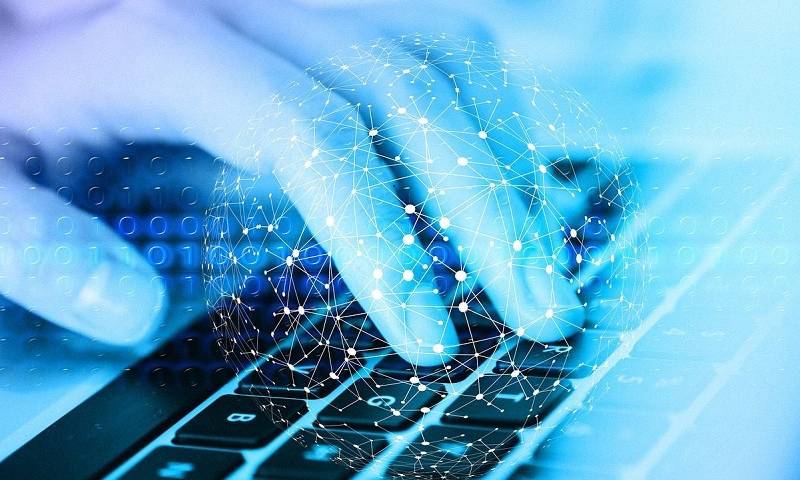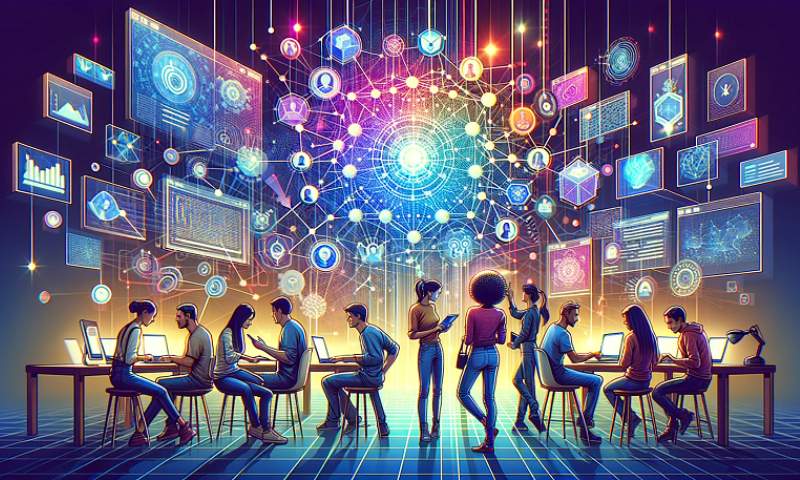Democratizing access to education with decentralized platforms isn’t just a buzzword—it’s a revolution. For too long, gates barred many from the rich gardens of knowledge. Now, imagine a world where those gates swing wide open, welcoming everyone. Decentralized education platforms are hammering down old barriers. They offer secure, open ways to learn that fit every life, any place. They level the field for all, from bustling cities to quiet rural areas. Your education is in your hands now, not locked behind pricey, closed doors. I’ve seen it, worked with it, and I’m here to tell you—we’re on the brink of something massive. Let’s dive into the meat of this change and explore how these new tools are not just changing the game, but rewriting the rules for everyone.
The Pillars of Educational Blockchain Platforms
Enabling Secure and Verifiable Credentials
Have you heard about blockchain verified credentials? They are digital records that no one can fake. They prove that you learned a skill or earned a degree. This change started with the need to trust what we see online. With blockchains, we made a way to check someone’s school history without worry.
This starts with something called a smart contract. Smart contracts are like promises in code form that live on the blockchain. They make sure that once you have a digital badge, it stays yours and is always valid. When you apply for a job, the boss can quickly see you have the right skills.
This is important for keeping things fair for everyone. Before, if you lost your paper degree, it was tough to prove your education. Now, your achievements live on the blockchain. Anyone can see them if you let them. This makes sure your hard work never goes unseen.
Promoting Inclusive Education Technology
Now, let’s talk about making sure everyone can learn, no matter where they are. Inclusive education technology is all about that. It’s like throwing a big party and making sure everyone gets an invite. Blockchain helps host this party in the education world. It offers open-source ed resources. This means learning tools that anyone can use and share.
Imagine you live far from big cities, or you don’t have much money. Before, it was hard to get the same books or classes rich kids in cities had. Now, with educational blockchains, you can reach the same learning platforms they do. You can also talk to other students from all over on peer-to-peer networks. This way, we build a world where your start in life doesn’t lock your future.
Teachers also benefit from this tech. They can find new ways to teach, pulling resources from across the globe. Schools that join the blockchain can share what they have. They can pull in what they need without huge fees or long waits.
What comes next is up to us. With these platforms, we can make sure learning is fair. We can put power back in the hands of students and teachers. With blockchain, we can build schools that listen to what learners need. That’s how we’re cracking open the doors to education for all.
These pillars stand tall, shaping how we think about and use technology in learning. By putting our trust in secure credentials and inviting everyone into the fold, we’re on the verge of a world where the chance to learn knows no bounds. That’s a future worth building, with each block in the educational blockchain bringing us one step closer to a world where information is free and knowledge is a gift that everyone can claim.
Revolutionizing Learning Through Decentralization
Empowering Open-Source Education Resources
Imagine a world where learning has no limits. No huge fees. No locked doors. That world is coming to life today, thanks to educational blockchain platforms. These platforms let us share knowledge freely. They use online learning innovation to break old rules.
We now see open-source education resources bloom. These are learning tools anyone can use, change, or share. They are free like the air we breathe. Teachers and experts from around the globe can add to these resources. This makes the pool of knowledge deep and rich.
Yet, it’s not just about gathering info. It’s also about trust. That’s where blockchain shines. Every piece of info can be checked. No lies can hide. This builds trust in what we learn.
But what about finding the right lesson? That’s where smart contract educational services help. They match learners with lessons that fit them best. Just like a key fits a lock.
Fostering Equitable Learning Opportunities
Let’s talk fairness now. Not all kids get the same chance to learn. This is big. But blockchain in education wants to fix it. It gives everyone, yes, everyone, a fair shot at learning. This is a huge step for kids everywhere.
It’s like a big, open field where every kid can play. Equitable learning opportunities mean each kid gets a space. No one’s left out. Each voice matters. Skills like reading and math can grow in every corner of the world.
Decentralized education apps are heroes here. They link learners with teachers in ways we never saw before. They make peer-to-peer learning networks shine. This way, kids and grown-ups teach each other. They swap skills. They swap stories.
Decentralized apps also let kids prove what they know. They can earn blockchain verified credentials. Later, they can show these to anyone, proving they know their stuff.
And then comes scalability in decentralized education. Big word, but it just means it can grow. More kids can learn without systems breaking down. It makes learning like a tree. It starts small but can touch the sky.
The best part? Cost. It drops. A lot. Reducing the cost of education brings more bright minds in. It’s like opening a gate in a tall fence. Now all can get through.
We’re also talking clear, wide-open honesty in learning. Transparency in online learning beats secrets. It keeps things clean. No dirty tricks.
There’s more than open doors here. There’s also a hand to guide you through them. A kind, smart hand. It’s an adventure, and everyone’s invited.
Each child can now hold the universe of knowledge in their hands. And each can share their own stars back. This is how we build a brighter world. Together.
Unleashing the Potential of Peer-to-Peer Education Networks
Scaling Decentralized Education for Wider Access
Imagine a school where you learn from friends all over the world. This school is not built with bricks. It’s built on bits and bytes, a space where we all can share and learn. This is the promise of peer-to-peer learning networks fueled by educational blockchain platforms. They connect us directly, without a middleman, so sharing knowledge is fast and free.
These networks use tech called blockchain. Think of it as a secure, online chain of blocks. Each block holds data that everyone can trust. Peer-to-peer means me to you, no one else in between. And when we use blockchain, our sharing becomes safe, private, and hard to break into.
But there’s a question – how do we make sure everyone can join in? Online learning innovation is the key. Creating easy, simple tech lets more friends hop on this learning train. Even those who live far away or have less money can now join us in class. It’s like opening a door to a room where the whole world can learn together.
Educational blockchain platforms help by keeping our study stuff safe. We all want to know that our hard work won’t get lost or stolen. Blockchain makes sure of that. And the cool part? It means our work is ours, and we can take it anywhere.
Advancing Digital Literacy in the Blockchain Era
Now, let’s talk about another big idea – digital literacy in the blockchain era. What does that mean? It’s all about learning how to live and learn in a world where computers and the internet are everywhere. It’s not just about reading or writing. It’s about understanding this new tech, so it helps us, not scares us.
With blockchain in the education industry, schools can teach us how to use this tech right. They can show us how to stay safe online and how to use blockchain to keep our stuff private. We’re not just talking about reading books or going to class. We’re learning to use tools that will be a big part of our future.
But wait, what if someone doesn’t know much about computers? That’s where inclusive education technology steps in. It makes sure nobody is left out. We’re making tech easy to use for everyone, no matter how much they know when they start.
We want everyone to have a chance to learn. By making blockchain easy and fun, we help more people get into this learning party. We’re building a world where everyone, big or small, near or far, can learn what they love.
These aren’t just dreams. They’re real, and they’re happening now. With smart contract educational services and decentralized apps, learning is no longer stuck inside four walls. We are the school. And this school is for everyone, everywhere.
Transforming Educational Access and Ownership
Integrating Tokenized Educational Assets
Imagine a world where your learning adds up to more than just grades. Every class you take, every project you complete, could earn you tokens. These tokens represent your hard work and talent. They’re part of what we call tokenized educational assets. And they can open new doors for your future, no matter who you are or where you live.
This is not just a dream; it’s starting to happen right now, thanks to educational blockchain platforms. What’s “blockchain”? It’s like a digital book that keeps track of who owns what. This book isn’t in one place. It’s copied across many computers. No one can cheat or change the records without everyone else knowing.
So, how does this help schools and students? Well, smart contract educational services use these digital books to store info about your learning. This way, your skills and knowledge can be easily shown to employers or other schools. It’s all secure and quick to share with those you choose.
Peer-to-peer learning networks also grow with blockchain. Students can teach students, trading knowledge for tokens. It’s schooling without the old school – flexible, fun, and fair!
Ensuring Transparency and Reducing Costs in Learning
Have you ever thought that school fees are too high? You’re not alone. One of the best things about online learning innovation on blockchain is they make lessons cheaper. Schools save money by using digital systems to manage courses, grades, and even attendance. They then pass on these savings to you in lower fees. This can help millions of kids get the education they deserve.
Blockchain also brings honesty to the classroom. With open-source education resources on distributed ledgers, anyone can check what’s being taught. Plus, you know exactly where your money goes.
Decentralized education apps use blockchain to take away hidden costs. These apps connect you directly to learning resources. No middleman means no extra fees. You get just what you need for less money.
But remember, for this all to work, we need more people to understand blockchain. That’s where digital literacy comes in. The more we know about these tech wonders, the more we can use them to learn in cool new ways.
Education is changing fast, and for the better. With blockchain, we’re tearing down old walls that keep knowledge locked up. We’re making a world where everyone can learn and own their success, openly and honestly. And that’s something to be excited about, don’t you think?
In this post, we explored how blockchain is changing education. We looked at secure credentials and how they open doors for all to learn. We talked about free resources that empower everyone. We saw how peer-to-peer networks make education reach further and help us all get savvy with digital tools. We also discussed how tokenized assets can transform who gets to learn and who holds the keys to knowledge.
Education is no longer just in a classroom; it’s becoming a shared online space thanks to blockchain. This tech ensures that what we learn is ours to keep, costs less, and is clear for all to see. It’s not just a change; it’s a full-scale education revolution. I believe in the power of blockchain to make learning better and fair for everyone, and I hope you’re just as excited about this future as I am. Let’s embrace this new era together!
Q&A :
What are decentralized platforms and how do they democratize access to education?
Decentralized platforms operate on a system where control and decision-making are distributed across various locations or stakeholders, rather than being centralized in one authority. They often use technology like blockchain to ensure transparency and security. In terms of education, these platforms provide an equitable access to learning resources for people all around the world, removing barriers such as high fees, location, and inadequate infrastructure that traditional institutions might have.
How can blockchain technology transform the education sector?
Blockchain technology has the potential to revolutionize the education sector by providing a secure and transparent way to store and share information. It can be used to verify the authenticity of academic credentials, manage the distribution of educational content, and create an immutable record of learners’ accomplishments. This transparency fosters trust and efficiency within educational transactions and collaborations globally.
What are the benefits of using decentralized platforms for education?
Decentralized platforms for education offer various benefits. They promote inclusivity by providing access to quality learning resources regardless of a user’s socioeconomic status. With decentralization, educational content is not controlled by a single entity, which encourages a diverse range of learning materials and opportunities for collaboration. Moreover, these platforms can reduce costs associated with traditional education systems, such as tuition fees and administrative expenses.
How do decentralized education platforms ensure equal access for all learners?
Decentralized education platforms leverage technology to eliminate many of the traditional barriers to education. They provide an open-access approach where learners, irrespective of their location, can reach educational content without the need for costly infrastructure. Community-driven models also allow for the adaptation of materials to suit various languages and cultural contexts, ensuring that content is relevant and accessible to a global audience.
Are there any challenges to adopting decentralized platforms in education?
While decentralized platforms hold great promise in democratizing education, challenges exist in their adoption. There can be resistance from established educational institutions, issues with digital literacy amongst potential users, and concerns about the quality of educational content. Additionally, the need for robust internet connectivity and adequate devices may still pose a barrier for some learners. Ensuring data privacy and adapting regulatory frameworks to this new model are also key considerations that must be addressed.


